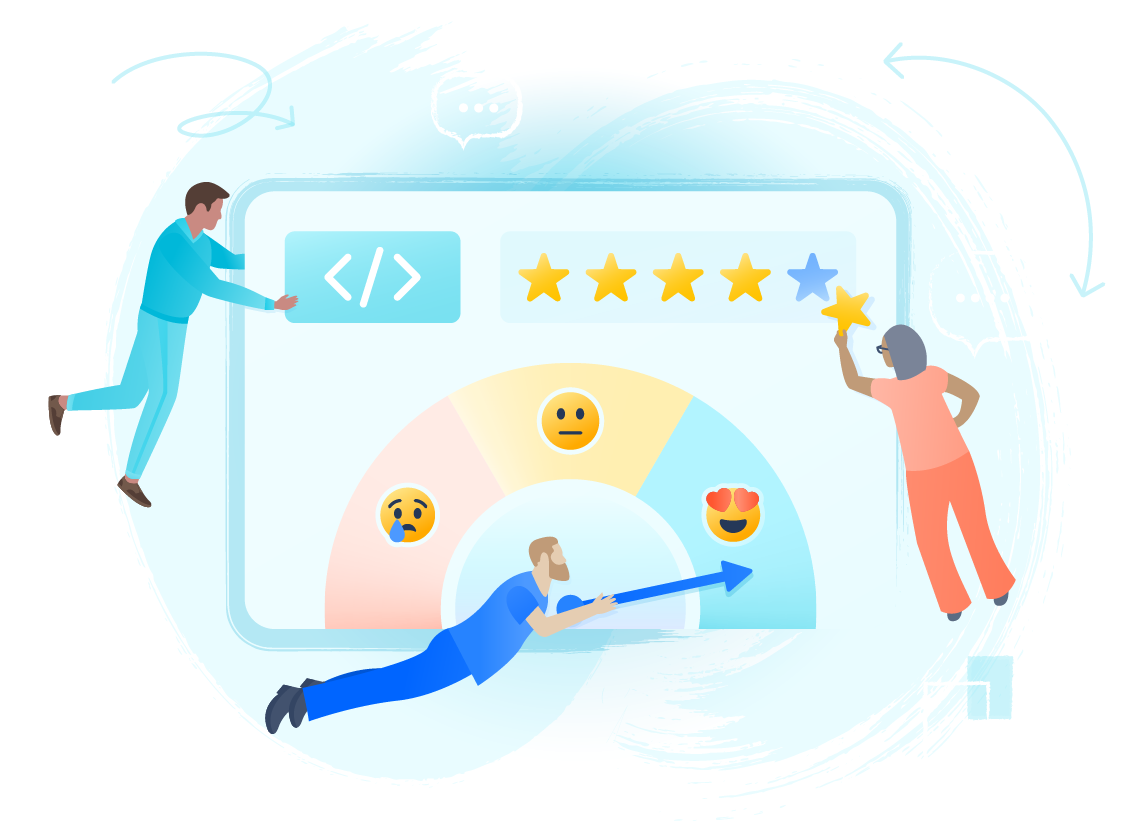Enquêtes over ervaringen van ontwikkelaars in actie
Een voorbeeld van hoe je je enquête over de ervaring van ontwikkelaars kunt uitvoeren met een enquêtetool.
Plot de resultaten van de enquête in een XY-grafiek met behulp van ons beoordelingssysteem: rode tekenen betekenen dat de aandacht van het team is vereist, gele tekenen geven verbeterpunten aan en groene tekenen geven aan dat er al goed aan wordt gewerkt.
Gebruik Confluence-whiteboards om je meest urgente vitale parameters in kaart te brengen, mogelijke oplossingen te bespreken en acties te plannen om de ontwikkelaarservaring te verbeteren.
Wat heb je nodig?
Extern
Enquêtetool
Digitale samenwerkingstool
Op locatie
Enquêtetool
Whiteboard of een groot vel papier
Post-its
Spelinstructies
Let op: De nuttigste enquêtes over de ervaring van ontwikkelaars zijn organisatiespecifiek. In het volgende spel nemen we een specifieke Atlassian-enquête op. Onze enquête werkt misschien al voor je team, maar we raden je toch aan om de enquête zo nodig aan te passen aan je team en organisatie.
1. Selecteer je vitale parameters 30 minuten
Om de ontwikkelaarservaring van je team echt te begrijpen, moet je de juiste vragen stellen. Bij Atlassian richten we onze vragen op de belangrijkste vitale parameters die ons helpen om de pijnpunten in de ontwikkelaarservaring te ontdekken. Vitale parameters zijn datapunten die fungeren als indicatoren voor de gezondheid en prestaties van het team. Net zoals de vitale functies van je lichaam, kunnen ze snel problemen in het systeem identificeren.
Vitale parameters zijn een cruciaal onderdeel van dit hele spel, dus maak voordat je begint een afspraak met je team over welke vitale parameters belangrijk zijn voor je activiteiten. We raden je aan om zes tot acht vitale parameters op te nemen in je eigen organisatiespecifieke enquête.
Dit zijn de acht vitale parameters die we hebben opgesteld voor ons onderzoek van Atlassian naar de ervaring van ontwikkelaars:
- Duurzame snelheid voor verzending: Hoe snel verstuurt je team code van hoge kwaliteit zonder dat de ontwikkelaars zich overwerken. Dit omvat de typische ontwikkelingscyclus vanaf het moment dat de ontwikkelaars in je team aan een user story beginnen te werken tot het moment dat een functie in productie wordt genomen.
- Wachttijd: De hoeveelheid tijd die de ontwikkelaars in je team besteden aan het wachten op builds, tests, codebeoordelingen en onnodige vergaderingen.
- Onafhankelijke uitvoering: Het vermogen van je team om te presteren zonder afhankelijk te zijn van andere teams, ongeacht wie de code bezit.
- Manieren van werken: hoeveel moeite het kost om een nieuwe manier van werken te ontdekken en te integreren die je team nodig heeft of waarvan je zou kunnen profiteren, waaronder tools, structuren, processen en werkwijzen.
- Externe normen: Het werk dat nodig is om te voldoen aan de normen van het bedrijf. Deze normen worden extern voor je team gegenereerd en vormen een aanvulling op productvereisten zoals beveiliging en conformiteit.
- Onderhoud: De hoeveelheid tijd die je team besteedt aan het onderhouden van de codebase, pipelines en infrastructuur. Dit werk wordt intern gegenereerd door je team.
- Onboarding: Hoe snel kan een ingenieur effectief te werk gaan nadat hij is aangenomen of intern is overgeplaatst.
- Tevredenheid van ontwikkelaars: Hoe tevreden ingenieurs zijn over hun productiviteit.
Verwerk onze vitale parameters in je organisatiespecifieke enquête, of gebruik de onze als inspiratie en stel je eigen enquête samen. Als een vitale parameter niet van toepassing is, kun je dat in stap twee uit de enquête verwijderen. Als je twijfelt over de relevantie van een vitale parameter, raden we je aan dat te laten staan, totdat je het spel minstens één keer hebt gespeeld.
Benieuwd naar hoe we deze vitale parameters hebben bedacht?
Eerst hebben we organisatiebrede enquêtes gehouden om gegevens te verzamelen. Vervolgens hebben we de principes van resultaatgerichte innovatie toegepast uit het boek van Anthony Ulwick, What Customers Want, om elk essentieel onderdeel een kansenscore te geven.
2. Voer je enquête uit 10 MIN.
Nadat je belangrijke tekens hebt gekozen of aangemaakt die van toepassing zijn op de ontwikkelaars in je team, moet je je ontwikkelaars voorbereiden op de enquête door met hen te communiceren over het doel van de Spellen en hoe je van plan bent om terug te komen op de resultaten van de enquête.
Nodig vervolgens al je ontwikkelaars uit om je enquête in te vullen. Stel een duidelijke deadline vast; we raden drie tot zeven dagen aan.
Als je niet iedereen kunt verplichten de enquête in te vullen, wil je misschien aanvullende informatie vastleggen, zoals functieniveau of locatie. Dit zorgt ervoor dat je geen vertekende resultaten krijgt.
De volgende enquête is gebaseerd op de vitale parameters van Atlassian. Als je ervoor kiest om verschillende vitale parameters toe te voegen, moet je je enquêtevragen aanpassen. Stel twee vragen per vitale paremeter: één over het belang van de vitale parameter voor de ontwikkelaar, en één over hoe tevreden de ontwikkelaar is over het huidige vermogen van zijn team om de essentiële functies waar te maken. Voeg bij je enquête een schaal toe van 0 tot 10, waarbij 0 staat voor 'niet belangrijk/niet tevreden' en 10 staat voor 'heel belangrijk/zeer tevreden'.
VOORBEELDVRAGEN VAN EEN ENQUÊTE OM DE ERVARING VAN ONTWIKKELAARS TE PEILEN:
Duurzame en snelle verzending
- Hoe belangrijk is het voor je team om code van hoge kwaliteit duurzaam te verzenden?
- Hoe tevreden ben je over het vermogen van je team om code van hoge kwaliteit duurzaam te verzenden?
Wachttijd
- Hoe belangrijk is het beperken van de wachttijd voor je productiviteit?
- Hoe tevreden ben je over de wachttijd van ontwikkelaars in je team?
Onafhankelijkheid van uitvoering
- Hoe belangrijk vind je het vermogen van je team om onafhankelijk van andere teams te presteren?
- Hoe tevreden ben je over de leveringsonafhankelijkheid van je team?
Manieren van werken
- Hoe belangrijk is het voor je team om nieuwe manieren van werken te ontdekken en te integreren, waaronder tools, processen en praktijken?
- Hoe tevreden ben je over het vermogen van je team om een nieuwe manier van werken te ontdekken en toe te passen, met inbegrip van tools, processen en werkwijzen?
Externe normen
- Hoe belangrijk voor je productiviteit is de hoeveelheid onderhoud of platformwerk die nodig is om te voldoen aan de extern gegenereerde bedrijfsnormen waarvan je team eigenaar is?
- Hoe tevreden ben je over de hoeveelheid onderhoud of platformwerk die nodig is om te voldoen aan de extern gegenereerde bedrijfsnormen waarvan je team eigenaar is?
Onderhoud
- Hoe belangrijk voor je productiviteit is de hoeveelheid inspanning die je nodig hebt om te voldoen aan de normen van je team met betrekking tot code, tools en pipelines?
- Hoe tevreden ben je over de hoeveelheid moeite die nodig is voor het onderhoud van code, tools en pipelines?
Onboarden
- Hoe belangrijk voor je productiviteit is de tijd die nieuwe medewerkers of medewerkers die intern zijn overgeplaatst nodig hebben om effectief te werk te gaan in je team?
- Hoe tevreden ben je over de tijd die nieuwe medewerkers of medewerkers die intern zijn overgeplaatst nodig hebben om effectief te werk te gaan in je team?
Tevredenheid van ontwikkelaars
- Hoe belangrijk is je tevredenheid voor je productiviteit?
- Hoe tevreden ben je over de productiviteit van ontwikkelaars in je team?
3. Bereken de resultaten 10 MIN.
Zodra iedereen de enquête heeft ingevuld, sluit je deze en bekijk je de gegevens.
Wijs vervolgens aan elk belangrijk teken een kansscore toe. Benoem eventuele uitschieters in je notities en bespreek ze met je team. Je kunt een spreadsheettool gebruiken om je berekeningen eenvoudiger te maken, als je wilt.
Zo bereken je de kansscore voor elk belangrijk teken:
- Bepaal eerst het gemiddelde belang en de gemiddelde tevredenheid van je belangrijke teken.
- Bijvoorbeeld: respectievelijk 8,22 en 5,88.
- Bereken vervolgens het verschil tussen het gemiddelde belang en de gemiddelde tevredenheid.
- Bijvoorbeeld: 8,22 - 5,88 = 2,34
- Tel tot slot het getal, als dit positief is, op bij het gemiddelde belang om de kansscore van je belangrijke teken te bepalen. Als het getal negatief is, is je gemiddelde belang je kansscore.
- Bijvoorbeeld: 8,22 + 2,34 = 10,56
Kansscore = belang + max (belang - tevredenheid, 0)
Maak vervolgens gebruik van de kansscore voor elk van je belangrijke tekenen en geef een score:
Tip: BRENG JE GEGEVENS IN KAART
Als het nuttig is om al je belangrijke tekenen te visualiseren in vergelijking met de andere, kun je je resultaten uitzetten op een spreidingsdiagram.
Wanneer moet je een belangrijk teken verwijderen?
Als de gemiddelde tevredenheidsscore hoger is dan de score van het gemiddelde belang, is het belangrijke teken waarschijnlijk niet erg belangrijk voor je team, of is je team er al erg tevreden over. In de toekomst kun je het belangrijke teken vervangen door een andere die je beter in de gaten wilt houden.
15+: Zeer achtergestelde gebieden die als eerste aangepakt moeten worden.
10-15: Gebieden die binnenkort aangepakt moeten worden.
<10: Gebieden waar goed aan gewerkt wordt, die niet behandeld hoeven te worden.
We hebben de resultaten van een voorbeeldenquête in een tabel hieronder ingedeeld.
Voorbeeldresultaten van de enquête
Belangrijke tekenen | Gemiddeld belang | Gemiddelde tevredenheid | Kansscore | Resultaten |
|---|---|---|---|---|
| Duurzame en snelle verzending | Gemiddeld belang 6.93 | Gemiddelde tevredenheid 4.83 | Kansscore 9.03 | Results GOOD |
| Wachttijd | Gemiddeld belang 7.48 | Gemiddelde tevredenheid 3.41 | Kansscore 11.55 | Results IMPROVEMENT NEEDED |
| Onafhankelijkheid van uitvoering | Gemiddeld belang 4.56 | Gemiddelde tevredenheid 6.34 | Kansscore 4.56 | Results GOOD |
| Manieren van werken | Gemiddeld belang 8.3 | Gemiddelde tevredenheid 1.33 | Kansscore 15.27 | Results NEEDS ACTION |
| Externe normen | Gemiddeld belang 2.67 | Gemiddelde tevredenheid 5.87 | Kansscore 2.67 | Results GOOD |
| Onderhoud | Gemiddeld belang 9.15 | Gemiddelde tevredenheid 3.23 | Kansscore 15.07 | Results NEEDS ACTION |
| Onboarden | Gemiddeld belang 3.6 | Gemiddelde tevredenheid 9.76 | Kansscore 3.6 | Results GOOD |
| Tevredenheid van ontwikkelaars | Gemiddeld belang 7.82 | Gemiddelde tevredenheid 5.49 | Kansscore 10.15 | Results IMPROVEMENT NEEDED |
Wiskunde voor gevorderden
Een optionele manier om meer uit je bevindingen te halen, is door de tevredenheidskloof te berekenen voor elk belangrijk teken.
Als je het verschil vindt tussen het gemiddelde belang en de gemiddelde tevredenheid van elk belangrijk teken, bereken je de tevredenheidskloof. Dat wil zeggen, het verschil tussen hoe belangrijk een belangrijk teken is voor je ontwikkelaars vergeleken met hoe tevreden ze erover zijn. Een kleinere tevredenheidskloof wijst erop dat het belangrijke teken ofwel van weinig belang is en weinig tevredenheid oplevert, ofwel van groot belang is en hoge tevredenheid oplevert. Dan heeft dat belangrijke teken in beide gevallen minder prioriteit. Een grotere tevredenheidskloof wijst erop dat een belangrijk teken zowel van groot belang is voor het team als dat ze op dit moment niet tevreden zijn over de manier waarop het team ermee omgaat, dus dat het aanpakken van het probleem een hoge prioriteit heeft.
4. Plan een vergadering om de resultaten te bespreken en oplossingen te bedenken 30 minuten
Bespreek tot slot de resultaten van de enquête met je team, identificeer de drie meest urgente kansvlakken en denk samen over oplossingen.
Om deze belangrijke vergadering te vergemakkelijken, raden we je aan een Confluence-pagina of Trello-bord aan te maken met een eenvoudige tabel met belangrijke tekenen waarop je beoordeling staat. Dit zorgt voor een effectieve, eenvoudige opstelling om teams op afstand of hybride teams op één lijn te houden. Je kunt de meest urgente gebieden markeren en zelfs een link delen naar de onbewerkte geanonimiseerde reacties als je dieper wilt graven.
Ook kun je Confluence-whiteboards gebruiken om secties aan te maken voor al je urgentste belangrijke tekenen en om mogelijke oplossingen te vinden, en om je eigen mening toe te voegen.
- Keer terug naar ideeën om de ideeën af te vinken die je gaat nastreven.
- Voeg actie-items toe aan de backlog.
- Zorg er na je vergadering voor dat iedereen toegang heeft tot de pagina en nodig ontwikkelaars uit om door te gaan met het toevoegen van ideeën.
Deze vergadering is een belangrijke manier voor het team om ontwikkelaars te laten zien dat hun stem belangrijk is en tot veranderingen kan leiden, wat op zijn beurt kan zorgen voor hoge voltooiingspercentages voor toekomstige enquêtes. Door ontwikkelaars een manier te bieden om input te geven, kunnen ze zich meer geïnvesteerd voelen in het resultaat, wat vaak leidt tot een beter vervolg en consistentere resultaten. Verschillende perspectieven zorgen voor betere oplossingen, en het is aan iedereen om verandering te creëren en te groeien, niet alleen aan de leidinggevenden.
Tip: SLA DEZE STAP NIET OVER!
Vragen stellen en niet over de uitkomst praten is vaak erger dan helemaal niets vragen.
Opvolgen
We raden aan om het spel voor enquête over de ervaringen van ontwikkelaars minstens twee keer per jaar uit te voeren als je tevreden bent met je successtatistieken en belangrijke tekenen, en elk kwartaal als je actief werkt aan het verbeteren van je ontwikkelaarservaring.
Andere spellen verkennen
Blijf up-to-date
Ontvang het laatste advies over spellen en werk als je je inschrijft voor onze nieuwsbrief.


.png?cdnVersion=2648)
.png?cdnVersion=2648)
.png?cdnVersion=2648)

